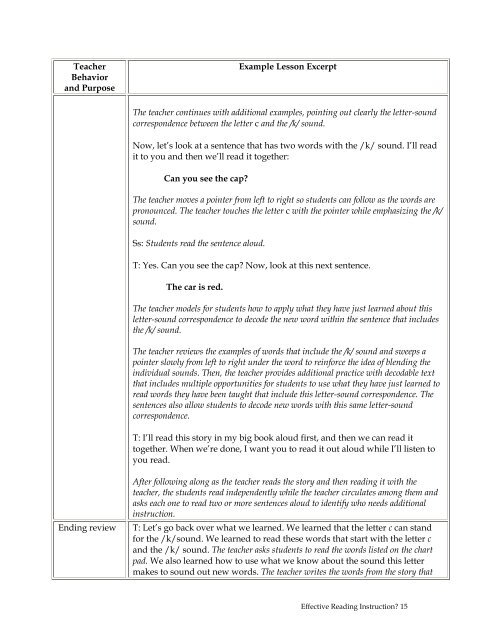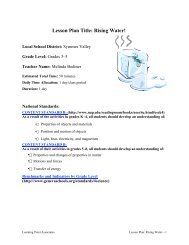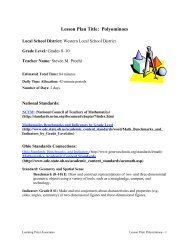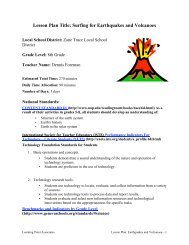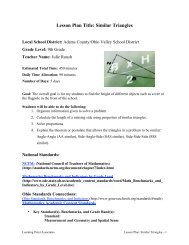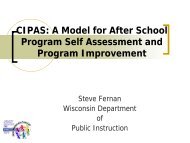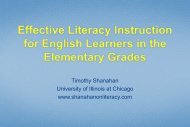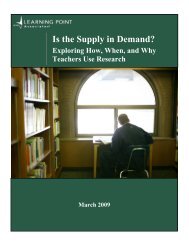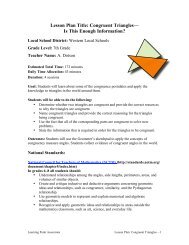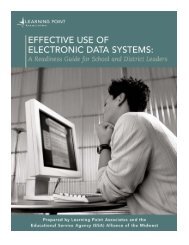A Closer Look at the Five Essential Components - Learning Point ...
A Closer Look at the Five Essential Components - Learning Point ...
A Closer Look at the Five Essential Components - Learning Point ...
You also want an ePaper? Increase the reach of your titles
YUMPU automatically turns print PDFs into web optimized ePapers that Google loves.
Teacher<br />
Behavior<br />
and Purpose<br />
Example Lesson Excerpt<br />
The teacher continues with additional examples, pointing out clearly <strong>the</strong> letter-sound<br />
correspondence between <strong>the</strong> letter c and <strong>the</strong> /k/ sound.<br />
Now, let’s look <strong>at</strong> a sentence th<strong>at</strong> has two words with <strong>the</strong> /k/ sound. I’ll read<br />
it to you and <strong>the</strong>n we’ll read it toge<strong>the</strong>r:<br />
Can you see <strong>the</strong> cap?<br />
The teacher moves a pointer from left to right so students can follow as <strong>the</strong> words are<br />
pronounced. The teacher touches <strong>the</strong> letter c with <strong>the</strong> pointer while emphasizing <strong>the</strong> /k/<br />
sound.<br />
Ss: Students read <strong>the</strong> sentence aloud.<br />
T: Yes. Can you see <strong>the</strong> cap? Now, look <strong>at</strong> this next sentence.<br />
The car is red.<br />
The teacher models for students how to apply wh<strong>at</strong> <strong>the</strong>y have just learned about this<br />
letter-sound correspondence to decode <strong>the</strong> new word within <strong>the</strong> sentence th<strong>at</strong> includes<br />
<strong>the</strong> /k/ sound.<br />
The teacher reviews <strong>the</strong> examples of words th<strong>at</strong> include <strong>the</strong> /k/ sound and sweeps a<br />
pointer slowly from left to right under <strong>the</strong> word to reinforce <strong>the</strong> idea of blending <strong>the</strong><br />
individual sounds. Then, <strong>the</strong> teacher provides additional practice with decodable text<br />
th<strong>at</strong> includes multiple opportunities for students to use wh<strong>at</strong> <strong>the</strong>y have just learned to<br />
read words <strong>the</strong>y have been taught th<strong>at</strong> include this letter-sound correspondence. The<br />
sentences also allow students to decode new words with this same letter-sound<br />
correspondence.<br />
T: I’ll read this story in my big book aloud first, and <strong>the</strong>n we can read it<br />
toge<strong>the</strong>r. When we’re done, I want you to read it out aloud while I’ll listen to<br />
you read.<br />
After following along as <strong>the</strong> teacher reads <strong>the</strong> story and <strong>the</strong>n reading it with <strong>the</strong><br />
teacher, <strong>the</strong> students read independently while <strong>the</strong> teacher circul<strong>at</strong>es among <strong>the</strong>m and<br />
asks each one to read two or more sentences aloud to identify who needs additional<br />
instruction.<br />
Ending review T: Let’s go back over wh<strong>at</strong> we learned. We learned th<strong>at</strong> <strong>the</strong> letter c can stand<br />
for <strong>the</strong> /k/sound. We learned to read <strong>the</strong>se words th<strong>at</strong> start with <strong>the</strong> letter c<br />
and <strong>the</strong> /k/ sound. The teacher asks students to read <strong>the</strong> words listed on <strong>the</strong> chart<br />
pad. We also learned how to use wh<strong>at</strong> we know about <strong>the</strong> sound this letter<br />
makes to sound out new words. The teacher writes <strong>the</strong> words from <strong>the</strong> story th<strong>at</strong><br />
Effective Reading Instruction? 15


